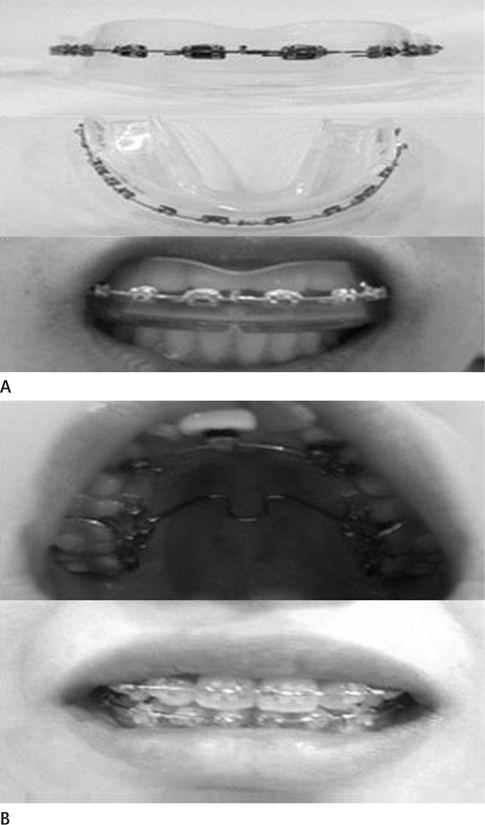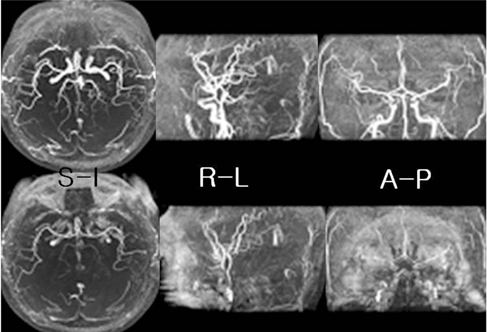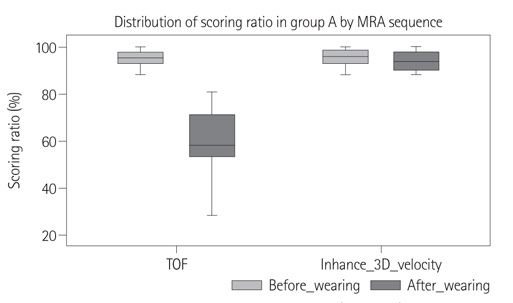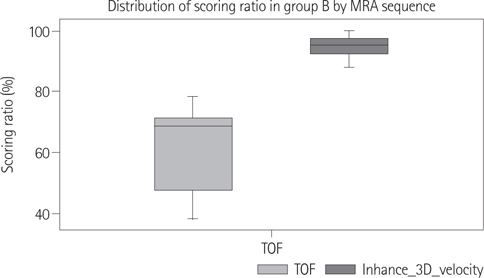J Korean Soc Radiol.
2011 Jul;65(1):1-8. 10.3348/jksr.2011.65.1.1.
Image Quality of the 3 Dimensional Phase-Contrast Technique in an Intracranial Magnetic Resonance Angiography with Artifacts Caused by Orthodontic Devices: A Comparison with 3 Dimensional Time-of-Flight Technique
- Affiliations
-
- 1Department of Radiology, Soonchunhyang University College of Medicine, Bucheon, Korea.
- 2Department of Radiology, Chosun University School of Medicine, Gwangju, Korea. dhk1107@hanmail.net
- KMID: 1443485
- DOI: http://doi.org/10.3348/jksr.2011.65.1.1
Abstract
- PURPOSE
To evaluate the degree of image distortion caused by orthodontic devices during a intracranial magnetic resonance angiography (MRA), and to determine the effectiveness of the 3 dimensional phase-contrast (3D PC).
MATERIALS AND METHODS
Subjects were divided into group A (n = 20) wearing a home-made orthodontic device, and group B (n = 10) with an actual orthodontic device. A 3.0T MR scanner was used, applying 3D time-of-flight (TOF) and 3D PC. Two board-certified radiologists evaluated images independently based on a four point scale classifying segments of the circle of Willis. Magnetic susceptibility variations and contrast-to-noise ratio (CNR) on maximum intensity projection images were measured.
RESULTS
In group A, scores of the 3D TOF and 3D PC were 2.84 +/- 0.1 vs. 2.88 +/- 0.1 (before) and 1.8 +/- 0.4 vs 2.83 +/- 0.1 (after wearing device), respectively. In group B, the scores of 3D TOF and 3D PC were 1.86 +/- 0.43 and 2.81 +/- 0.15 (p = 0.005), respectively. Magnetic susceptibility variations showed meaningful results after wearing the device (p = 0.0001). CNRs of the 3D PC before and after wearing device were 142.9 +/- 6.6 vs. 140.8 +/- 7.2 (p = 0.7507), respectively. In the 3D TOF, CNRs were 324.8 +/- 25.4 vs. 466.3 +/- 41.7 (p = 0.0001).
CONCLUSION
The 3D PC may be a solution method for distorted images by magnetic susceptibility in the intracranial MRA compared with 3D TOF.
MeSH Terms
Figure
Reference
-
1. Acheson J, Boyd WN, Hugh AE, Hutchinson EC. Cerebral angiography in ischemic cerebrovascular disease. Arch Neurol. 1969; 20:527–532.2. White PM, Wardlaw JM, Easton V. Can noninvasive imaging accurately depict intracranial aneurysms? A systematic review. Radiology. 2000; 217:361–337.3. Yang JJ, Hill MD, Morrish WF, Hudon ME, Barber PA, Demchuk AM, et al. Comparison of pre- and postcontrast 3D time-of-flight MR angiography for the evaluation of distal intracranial branch occlusions in acute ischemic stroke. AJNR Am J Neuroradiol. 2002; 23:557–567.4. Remonda L, Senn P, Barth A, Arnold M, Lövblad KO, Schroth G. Contrast-enhanced 3D MR angiography of the carotid artery: comparison with conventional digital subtraction angiography. AJNR Am J Neuroradiol. 2002; 23:213–219.5. Campeau NG, Huston J 3rd, Bernstein MA, Lin C, Gibbs GF. Magnetic resonance angiography at 3.0 Tesla: initial clinical experience. Top Magn Reson Imaging. 2001; 12:183–120.6. Al-Kwifi O, Emery DJ, Wilman AH. Vessel contrast at three Tesla in time-of-flight magnetic resonance angiography of the intracranial and carotid arteries. Magn Reson Imaging. 2002; 20:181–187.7. Frayne R, Goodyear BG, Dickhoff P, Lauzon ML, Sevick RJ. Magnetic resonance imaging at 3.0 Tesla: challenges and advantages in clinical neurological imaging. Invest Radiol. 2003; 38:385–340.8. Wilms G, Bosmans H, Demaerel P, Marchal G. Magnetic resonance angiography of the intracranial vessels. Eur J Radiol. 2001; 38:10–18.9. Walker MT, Tsai J, Parish T, Tzung B, Shaibani A, Krupinski E, et al. MR angiographic evaluation of platinum coil packs at 1.5T and 3T: an in vitro assessment of artifact production: technical note. AJNR Am J Neuroradiol. 2005; 26:848–885.10. Willinek WA, Born M, Simon B, Tschampa HJ, Krautmacher C, Gieseke J, et al. Time-of-flight MR angiography: comparison of 3.0-T imaging and 1.5-T imaging--initial experience. Radiology. 2003; 229:913–920.11. Yu HS, Ryu YK, Lee JY. A study on the distributions and trends in malocclusion patients from department of orthodontics, college of dentistry, Yonsei university. Korean J Orthod. 1999; 29:267–276.12. Lee YK, Cha JY, Yu HS, Hwang CJ. Effect of metal primer and thermocycling on shear bonding strength between the orthodontic bracket and gold alloy. Korean J Orthod. 2009; 39:320–329.13. Liu JK, Chang LT, Chuang SF, Shieh DB. Shear bond strengths of plastic brackets with a mechanical base. Angle Orthod. 2002; 72:141–145.14. Gizewski ER, Ladd ME, Paul A, Wanke I, Göricke S, Forsting M. Water excitation: a possible pitfall in cerebral time-of-flight angiography. AJNR Am J Neuroradiol. 2005; 26:152–155.15. Griswold MA, Jakob PM, Nittka M, Goldfarb JW, Haase A. Partially parallel imaging with localized sensitivities (PILS). Magn Reson Med. 2000; 44:602–609.16. Weiger M, Pruessmann KP, Leussler C, Röschmann P, Boesiger P. Specific coil design for SENSE: a six-element cardiac array. Magn Reson Med. 2001; 45:495–504.17. Wilson GJ, Hoogeveen RM, Willinek WA, Muthupillai R, Maki JH. Parallel imaging in MR angiography. Top Magn Reson Imaging. 2004; 15:169–185.18. Hiai Y, Kakeda S, Sato T, Ohnari N, Moriya J, Kitajima M, et al. 3D TOF MRA of intracranial aneurysms at 1.5 T and 3 T: influence of matrix, parallel imaging, and acquisition time on image quality - a vascular phantom study. Acad Radiol. 2008; 15:635–664.19. Marks MP, Pelc NJ, Ross MR, Enzmann DR. Determination of cerebral blood flow with a phase-contrast cine MR imaging technique: evaluation of normal subjects and patients with arteriovenous malformations. Radiology. 1992; 182:467–476.20. Oelerich M, Lentschig MG, Zunker P, Reimer P, Rummeny EJ, Schuierer G. Intracranial vascular stenosis and occlusion: comparison of 3D time-of-flight and 3D phase-contrast MR angiography. Neuroradiology. 1998; 40:567–573.21. Shonai T, Carpenter JS, Lemieux SK, Harada K, Omori K, Kaneko N, et al. Improvement of vessel visibility in time-of-flight MR angiography of the brain. J Magn Reson Imaging. 2008; 27:1362–1370.22. Grayev A, Shimakawa A, Cousins J, Turski P, Brittain J, Reeder S. Improved time-of-flight magnetic resonance angiography with IDEAL water-fat separation. J Magn Reson Imaging. 2009; 29:1367–1374.23. Dion JE, Gates PC, Fox AJ, Barnett HJ, Blom RJ. Clinical events following neuroangiography: a prospective study. Stroke. 1987; 18:997–1004.24. Grzyska U, Freitag J, Zeumer H. Selective cerebral intraarterial DSA. Complication rate and control of risk factors. Neuroradiology. 1990; 32:296–229.25. Randoux B, Marro B, Koskas F, Duyme M, Sahel M, Zouaoui A, et al. Carotid artery stenosis: prospective comparison of CT, three-dimensional gadolinium-enhanced MR, and conventional angiography. Radiology. 2001; 220:179–185.26. Hirai T, Korogi Y, Ono K, Nagano M, Maruoka K, Uemura S, et al. Prospective evaluation of suspected stenoocclusive disease of the intracranial artery: combined MR angiography and CT angiography compared with digital subtraction angiography. AJNR Am J Neuroradiol. 2002; 23:93–101.27. Bosmans H, Marchal G, Lukito G, Yicheng N, Wilms G, Laub G, et al. Time-of-flight MR angiography of the brain: comparison of acquisition techniques in healthy volunteers. AJR Am J Roentgenol. 1995; 164:161–167.28. White PM, Teasdale EM, Wardlaw JM, Easton V. Intracranial aneurysms: CT angiography and MR angiography for detection prospective blinded comparison in a large patient cohort. Radiology. 2001; 219:739–749.29. Ozsarlak O, Van Goethem JW, Parizel PM. 3D time-of-flight MR angiography of the intracranial vessels: optimization of the technique with water excitation, parallel acquisition, eight-channel phased-array head coil and low-dose contrast administration. Eur Radiol. 2004; 14:2067–2071.30. Korosec FR, Mistretta CA. MR angiography: basic principles and theory. Magn Reson Imaging Clin N Am. 1998; 6:223–256.31. Hollnagel DI, Summers PE, Poulikakos D, Kollias SS. Comparative velocity investigations in cerebral arteries and aneurysms: 3D phase-contrast MR angiography, laser Doppler velocimetry and computational fluid dynamics. NMR Biomed. 2009; 22:795–808.
- Full Text Links
- Actions
-
Cited
- CITED
-
- Close
- Share
- Similar articles
-
- Artifacts in MR Angiography of the Intracranial Vessels Using the 3D TOF and 3D PC Techniques
- Accelerated Time-of-Flight Magnetic Resonance Angiography with Sparse Undersampling and Iterative Reconstruction for the Evaluation of Intracranial Arteries
- Two-Dimensional Image-Based Respiratory Navigator for Free-Breathing Coronary Magnetic Resonance Angiography
- Development and Feasibility Study for Phase Contrast MR Angiography at Low Tesla Open-MRI System
- Detection of Intracranial Aneurysms by MRA and Conventional Angiography







